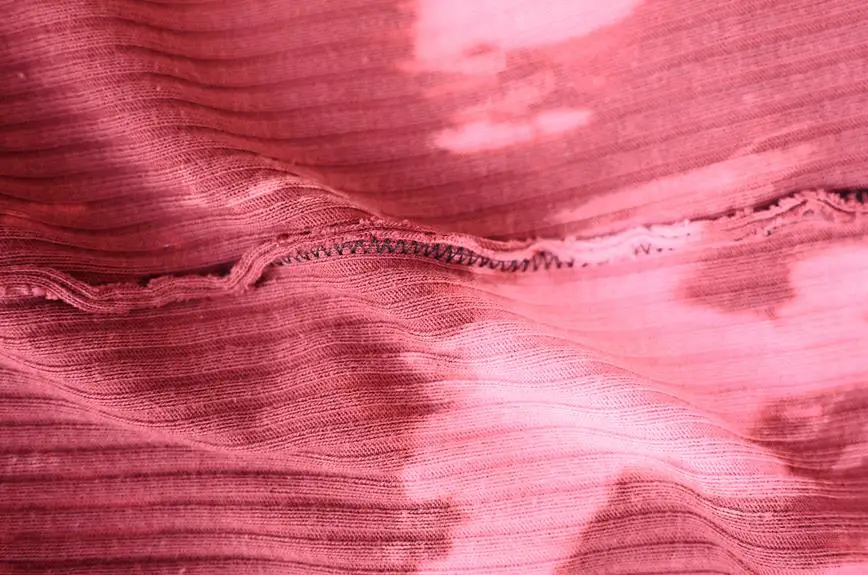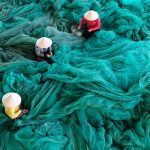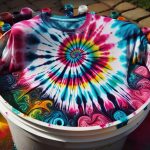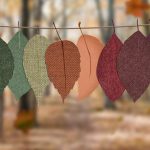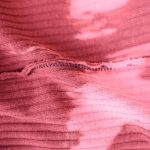Do you ever wonder about the nuanced distinction between garment dyed and pigment dyed fabrics?
Garment dyeing involves coloring the fabric after it's been cut and sewn into the final garment, resulting in a softer, more natural appearance.
On the other hand, pigment dyeing occurs when the color is added to the fabric after it's been woven, enhancing the fabric's texture but often producing a more washed-out look.
Understanding these methods can empower you to make informed decisions about the clothing you wear and how to care for it.
Key Takeaways
- Garment dyeing involves dyeing fabric after garment construction, resulting in a unique washed-out look and softer feel.
- Pigment dyeing applies color directly to the fabric surface using finely ground color particles mixed with a binding agent, creating a soft, washed-out look and vintage appearance.
- Garment dyeing allows the fabric to absorb the dye, providing a softer, natural appearance, while pigment dyeing sits on the fabric's surface for a textured look.
- Garment dyeing produces rich, saturated colors with even and consistent color distribution, while pigment dyeing may show variations in color intensity after washing.
The Basics of Garment Dyeing
When garment dyeing, the fabric is dyed after the garment has been constructed. This process allows for a unique, washed-out look and a softer feel compared to traditional dyeing methods. The garment dyeing process begins with fully constructed garments made from pre-dyed, pre-shrunk fabric.
The garments are then subjected to a dye bath, where the color is absorbed by the fabric. This method results in a more natural, lived-in appearance, with subtle color variations that enhance the overall aesthetic of the garment.
One of the key aspects to consider with garment dyeing is its impact on fabric quality. The process can affect the fabric in various ways, including softening the hand feel, reducing shrinkage, and creating a more relaxed, worn-in look. However, it's essential to carefully control the dyeing process to minimize any potential negative effects on the fabric, such as color inconsistencies or compromised tensile strength.
Understanding the intricacies of the garment dyeing process is crucial for achieving desirable fabric quality effects while maintaining the integrity of the garment.
The Process of Pigment Dyeing
When it comes to the process of pigment dyeing, there are a few key points to consider. Pigment dye characteristics and the differences in color application are important aspects to understand.
Let's explore how these factors contribute to the unique qualities of pigment dyed fabrics.
Pigment Dye Characteristics
Using a mixture of finely ground color particles, you create pigment-dyed fabrics by applying the dye directly to the fabric surface. This process differs from garment dyeing, where the fabric is dyed after it's been cut and sewn. Pigment dye application involves binding the color particles to the fabric with a binding agent, resulting in a soft, washed-out look. This method allows for a wide range of colors and a vintage appearance. However, compared to garment-dyed fabrics, pigment-dyed fabrics may have lower colorfastness, meaning the colors may fade over time with repeated washing. Below is a comparison of the characteristics of pigment-dyed fabrics and garment-dyed fabrics:
| Characteristic | Pigment-Dyed Fabrics | Garment-Dyed Fabrics |
|---|---|---|
| Application | Direct to fabric surface | After garment construction |
| Colorfastness | May have lower colorfastness | Generally higher colorfastness |
| Appearance | Soft, washed-out look | Rich, saturated colors |
This table illustrates the differences in the characteristics of pigment-dyed fabrics and garment-dyed fabrics.
Color Application Differences
To achieve the pigment dyeing process, you mix finely ground color particles with a binding agent and apply the mixture directly to the fabric surface. This color application technique allows the pigment to sit on top of the fabric rather than penetrating the fibers.
The dyeing process involves carefully applying the pigment mixture to ensure even coverage and vibrant color. Unlike garment dyeing techniques where the fabric absorbs the dye, pigment dyeing creates a more textured and vintage look, as the color remains on the surface.
The binding agent helps the color particles adhere to the fabric, resulting in a durable and long-lasting color application. Understanding these differences in dyeing techniques is essential for achieving the desired aesthetic and durability in pigment-dyed fabrics.
Key Differences in Color Absorption
When it comes to color absorption, garment dyed and pigment dyed fabrics have some key differences. Understanding how each type of dye interacts with the fabric can help you make informed decisions about which one is best for your needs.
Let's take a closer look at the specific differences in color absorption between garment dyed and pigment dyed fabrics.
Garment Dye Vs Pigment Dye
You'll notice a distinct difference in color absorption between garment dyed and pigment dyed fabrics.
Garment dye penetrates the fabric, resulting in a softer, more natural appearance. This process enhances the fabric's quality by allowing for a more even and consistent color distribution.
On the other hand, pigment dye sits on the fabric's surface, providing a more textured and vintage look. While this technique offers excellent colorfastness and longevity, it may not permeate the fabric as deeply as garment dye. As a result, pigment dyed fabrics may show variations in color intensity, especially after washing.
Understanding the color absorption differences between these two dyeing methods can help you choose the best option based on your desired aesthetic and the fabric's intended use.
Color Absorption Differences
You can observe a noticeable difference in color absorption between garment dyed and pigment dyed fabrics. Garment dyeing involves immersing the finished garment into a dye bath, allowing the fabric to fully absorb the color. This results in deep, rich hues with excellent color penetration.
On the other hand, pigment dyeing applies color to the surface of the fabric using pigments that adhere to the fibers. The color sits on top of the fabric, creating a more washed-out or vintage look.
The dyeing techniques for these processes play a significant role in the final color absorption. Understanding these differences can help you choose the right fabric for your desired aesthetic, whether you prefer the deep, saturated colors of garment dyed fabrics or the more subdued, worn-in appearance of pigment dyed fabrics.
Impact on Fabric Texture and Feel
After garment dyeing, the fabric will feel softer and more flexible, while pigment dyeing tends to create a stiffer and more textured feel. The process of garment dyeing involves washing the fabric with dye after it's been cut and sewn, allowing the color to fully saturate the material. This results in a softer, more lived-in texture because the fabric has already been preshrunk during the garment dyeing process. The colors also appear more muted and vintage-like due to the dye penetrating the fabric fibers, resulting in a softer, less vibrant color compared to pigment dyeing.
On the other hand, pigment dyeing involves applying colored pigments to the fabric's surface, which sit on top of the fibers rather than fully penetrating them. This creates a stiffer and more textured feel, as the pigments can make the fabric slightly rougher and less pliable. The colors achieved through pigment dyeing tend to be more intense and vibrant due to the pigments sitting on top of the fabric, giving it a more saturated and bold appearance. However, this method may also lead to slightly reduced fabric durability due to the pigments only adhering to the surface.
Colorfastness and Longevity
Once the fabric has been garment dyed or pigment dyed, it's important to consider the colorfastness and longevity of the colors. Ensuring that the colors retain their vibrancy and don't fade over time is crucial for maintaining the garment's aesthetic appeal. Here are some key factors to consider in relation to colorfastness and longevity:
- Color Retention: The dyeing process and fabric treatment play a significant role in determining how well the colors will retain their original vibrancy. Understanding the specific dyeing techniques used and the treatment applied to the fabric can provide insight into the long-term color retention of the garment.
- Fabric Treatment: The type of treatment applied to the fabric after the dyeing process can greatly impact its colorfastness and longevity. Different treatments, such as UV protection or color sealing, can help preserve the colors and prevent them from fading due to environmental factors or washing.
- Longevity: Assessing the overall durability and lifespan of the dyed fabric is essential. Factors such as the quality of the dye, fabric composition, and construction can influence the garment's longevity and color retention over time.
- Dyeing Process: Understanding the specific dyeing process used, whether it's garment dyeing or pigment dyeing, can provide insights into how well the colors will hold up over time. Different dyeing methods can have varying effects on colorfastness and longevity.
Considerations for Clothing Care
To maintain the vibrancy and longevity of garment dyed and pigment dyed fabrics, proper care and attention are essential. Both types of dyed fabrics have specific fabric care requirements that, if followed, can significantly extend their clothing longevity.
When caring for garment dyed fabrics, it's crucial to wash them in cold water with a gentle detergent to prevent color fading. Additionally, turning the garment inside out before washing can help preserve the color and texture.
Pigment dyed fabrics, on the other hand, require a more delicate approach. These fabrics should be washed separately to avoid color bleeding onto other garments. It's also important to air dry both types of dyed fabrics to prevent shrinkage and preserve the color.
Avoiding the use of harsh chemicals like bleach and opting for air drying over machine drying can significantly contribute to the longevity of garment dyed and pigment dyed fabrics. By adhering to these fabric care requirements, you can ensure that your dyed clothing maintains its vibrancy and quality for an extended period.
Choosing the Right Dyeing Method
When choosing the right dyeing method for your fabric, consider the desired color intensity and level of colorfastness. Different dyeing methods offer varying results, so it's important to select the most suitable one for your specific needs.
Here are some crucial factors to consider:
- Garment dye vs fabric printing: Determine whether you want the color to permeate the entire fabric (garment dye) or to be applied only to the surface (fabric printing).
- Dye application techniques: Research different dye application techniques such as immersion dyeing, direct application, or resist dyeing to find the one that aligns with your desired outcome.
- Colorfastness testing: Prioritize conducting thorough colorfastness tests to ensure that the dye will withstand washing, light exposure, and other environmental factors.
- Dye material selection: Select the appropriate dye material based on the type of fabric you're dyeing. Different fabrics may require different types of dye for optimal results.
Frequently Asked Questions
Can Garment Dyed and Pigment Dyed Fabrics Be Mixed and Matched in the Same Garment?
Yes, you can mix and match garment dyed and pigment dyed fabrics in the same garment. However, ensure color matching and consistency, as well as fabric compatibility and durability, to achieve a cohesive and long-lasting result.
Are There Any Environmental Considerations for Garment Dyeing and Pigment Dyeing Processes?
When considering environmental impact, dyeing regulations, sustainable practices, and dyeing techniques, it's essential to understand the nuances of garment dyeing and pigment dyeing processes. Each method presents unique considerations for environmental sustainability and regulatory compliance.
How Does the Cost of Garment Dyeing Compare to Pigment Dyeing?
When comparing the cost of garment dyeing to pigment dyeing, it's essential to consider the specific dyeing techniques used. Garment dyeing often involves a more complex and labor-intensive process, resulting in higher production costs.
Can Garment Dyed and Pigment Dyed Fabrics Be Easily Re-Dyed at Home if the Color Fades?
To maintain color and re-dye garment or pigment dyed fabrics at home, follow specific dyeing instructions. For garment dyed fabrics, re-dyeing may require a more involved process due to the initial dyeing method.
Are There Specific Types of Fabrics That Are Better Suited for Garment Dyeing Versus Pigment Dyeing?
When considering types of fabrics for dyeing processes, it's essential to choose based on their suitability for garment dyeing or pigment dyeing. Different fabrics vary in colorfastness, affecting re-dyeing at home if the color fades.

